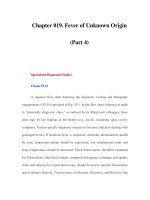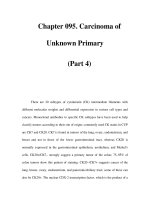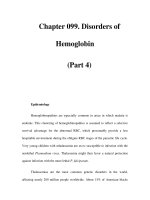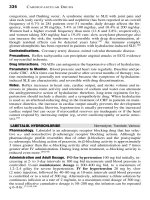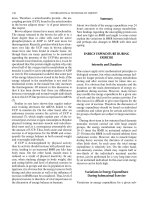Cytologic Detection of Urothelial Lesions - part 4 ppt
Bạn đang xem bản rút gọn của tài liệu. Xem và tải ngay bản đầy đủ của tài liệu tại đây (293.2 KB, 20 trang )
50 2. Diagnostic Categories
Figure 2.28. Assorted Casts—voided urine: Types of casts can be im-
portant clinical information and should be mentioned in addition to any
epithelial atypia. (200x)
Benign Non-epithelial Elements 51
Figure 2.29. Red Cell Casts—voided urine: Fragmented red blood cells
are arranged in a cylinder with relatively parallel sides. (400x)
52 2. Diagnostic Categories
Figure 2.30. Non-viral Inclusions—voided urine: Red opaque inclusions
in large degenerated spheres are notto be confused with virus infected cells.
The exact origin of these inclusions is not known. They do not correlate
with any disease process. They are a frequent finding in voided urines,
especially in the presense of inflammation and in older patients. (600x)
Benign Non-epithelial Elements 53
Figure 2.31. Non-viral Inclusions—voided urine: Red inclusions within
degenerated cells are frequentlyseen in voided urinesand are of no apparent
clinical significance. They usually accompany acute inflammation. (600x)
54 2. Diagnostic Categories
Figure 2.32. Benign Crystals—bladder washing: Numerous crystals are
seen in this bladder washing specimen. The crystals range in size and shape
and few benign urothelial cells are observed. (600x)
Atypical Urothelial Cells Indeterminate for Neoplasia 55
Figure 2.33. Atypical Cells, Short of Neoplastic—bladder washing:
When cytologic criteria fall between reactive and neoplastic, an indeter-
minate category is prudent. Clinical management usually includes repeat
voided urines, followed by bladder washing and biopsy if atypical cells
persist. (400x)
56 2. Diagnostic Categories
Suggested Reading
Boon ME, van Keep JM, and Kok LP: Polyomavirus infection versus high
grade bladder carcinoma. Acta Cytol 1989; 33:887–893.
Layfield LJ, Elsheikh TM, Fili A, Nayar R, Shidham V. Review of the
state of the art and recommendations of the Papanicolaou Society of
Cytopathology for urinary cytology procedures and reporting. Diagn
Cytopathol 2004;30:24–30.
Roussel F, Picquenot J-M, and Rousseau O: Identification of human papil-
lomavirus antigen in a bladder tumor. Acta Cytol 1991; 35:273–276.
Santos RL, Manfrinatto JA, Cia EM, Carvalho RB, Quadros KR, Alves-
Filho G, Mazzali M. Urine cytology as a screening method for polyoma
virus active infection. Transplant Proc. 2004;36:899–901.
3
Grading Urothelial Neoplasms
(Transitional Cell Carcinoma,
TCC)
Terminology
Historic
Historically, terminology describing urinary tract lesions has been
almost as confusing as lymphoma categories. A popular histologic
grading system divides the neoplasms into three groups: Grade
I (low), Grade II (medium), and Grade III (high). In those sys-
tems that add a fourth grade, equivalence may be accomplished
by placing papillomas in the Grade I category, the low grade le-
sions in Grade II, etc. Including papillomas with Grade I lesions
may be justified by the evidence that these benign appearing papil-
lomas may progress to higher grade carcinomas, or at least iden-
tify the patient as at risk for subsequent development of a high
grade lesion. From a patient management standpoint, all papillary
lesions of the urinary bladder can be considered cancerous. How-
ever, the current general opinion, that the most treacherous lesions
are the high grade sessile (flat) lesions, capable of quickly invad-
ing, makes the low grade papillary lesions less noteworthy than
previously considered. Therefore, cytopathologists may prefer to
divide the neoplasms of the urothelium simply into low and high
grade.
57
58 3. Grading Urothelial Neoplasms
Table 3. The WHO/ISUP Consensus Classification
Normal
May include cases formerly diagnosed as “mild dysplasia”
Hyperplasia
Flat hyperplasia
Papillary hyperplasia
Flat lesions with atypia
Reactive (inflammatory) atypia
Atypia of unknown significance
Dysplasia (low grade intraurothelial neoplasia)
Carcinoma in situ (high grade intraurothelial neoplasia)
Papillary neoplasms
Papilloma—Inverted papilloma
Papillary neoplasm of low malignant potential (PUNLMP)
Papillary carcinoma, low grade
Papillary carcinoma, high grade
Invasive neoplasms
Lamina propria invasion
Muscularis propria (detrusor muscle) invasion
Terminology used in this Handbook
The newest terminology considers the natural history of urothelial
neoplasia and the relationship to premalignant and preinvasive le-
sions. In 1998, members of the International Society of Urologic
Pathologists (ISUP) met to discuss bladder terminology and make
recommendations to the World Health Organization (WHO) Com-
mittee on urothelial tumors. The resulting Consensus Classification
of Urothelial (Transitional Cell) Neoplasms of the Urinary Bladder
is outlined on Table 3. Comparison with previous popular termi-
nologies is tabulated on Table 4.
Conveniently, the new classification closely “fits” the way in
which most cytopathologists categorize urinary cytologic samples
(Table 5). Since the morphologic changes in the lowest grade le-
sions are essentially identical to normal urothelium, the sensitivity
of cytology for the accurate diagnosis of these tumors is low. Hyper-
plasia is included in the categories of the WHO/ISUP classification,
but is rarely recognized in a cytologic specimen (Fig. 3.1). However,
the risk that a low grade lesion may progress to invasive carcinoma
is minimal, reducing the negative consequences of a false negative.
High grade lesions fortunately are easily recognized and reliably
Low Grade Urothelial Tumors (Grade I) 59
Table 4. Histologic Grading Systems for Urothelial Carcinoma and
Cytologic Equivalents
Cytologic Equivalent 1998 WHO/ISUP Murphy 1973 WHO
Flat
lesions
Reactive/
inflammatory
changes
Reactive Atypia
or Atypia of
unknown
significance
None None
Atypia indeterminate
for neoplasia
Dysplasia None None
High grade urothelial
carcinoma
Carcinoma in
Situ
None None
Papillary
lesions
Normal cells, clusters
in voided urine
Papilloma Papilloma Papilloma
Normal or atypical
cells
Low Malignant
Potential
(LMP)
Low grade Grade 1
Atypical cells/low
grade carcinoma
Low grade High grade Grade 2
High grade urothelial
carcinoma
High grade High grade Grade 3
diagnosed so that immediate histologic confirmation and treatment
can proceed.
Low Grade Urothelial Tumors (Grade I,
Papilloma, Papillary Urothelial Neoplasm
of Low Malignant Potential)
Diagnosis Cytologic Criteria
Papillary Neoplasm chromatin coarseness
Of Low Malignant loss of “honeycomb”
Potential (LMP) nuclear shape elongated
(Grade I) nuclear enlargement
nucleoli indistinct
umbrella cells retained
According to most authors, the cytologic diagnosis of low grade
urothelial lesions is made with difficulty. One of the obvious reasons
is that theselesions do not shedas readily as thehigher grade lesions,
and therefore the amount of diagnosable material in a given sample
60 3. Grading Urothelial Neoplasms
is small. Another reason is that the DNA content of these tumors
is at or near diploid, and so the nuclear chromatin of these cells is
essentially identical to that of the normal mucosa. The low grade
lesions exhibit a spectrum of features from changes identical to
benign urothelium (as in papilloma) to changes of neoplasia (as in
low grade urothelial carcinoma) that, in some instances, may be
distinguished from benign conditions (Figs. 3.2, 3.3). In the lowest
grade lesions, nuclear crowding is the first clue that the epithelium
is abnormal (Figs. 3.4–3.6).
Table 5. Progressive Cytologic Changes in The Grading of Urothelial
Neoplasms
Diagnosis Cytologic Criteria
Hyperplasia cellular crowding
“honeycomb” present
chromatin normal
umbrella cells retained
Papillary Neoplasm of chromatin coarseness
Low Malignant Potential loss of “honeycomb”
(Grade I) nuclear shape elongated
nuclear enlargement
nucleoli indistinct
umbrella cells retained
Low Grade haphazard growth pattern
(Grade II) mitoses infrequent
definite increased N/C
cellular enlargement
uniform granular chromatin
nuclear membrane irregularity
homogeneous cytoplasm
thickened nuclear membranes
eccentric nucleus
distinct nucleoli, but small
umbrella cells variable
High Grade large cells, often single
(Grade III) very high N/C
irregular nuclear outlines
nucleoli prominent
cytoplasmic differentiation, i.e.
glandular/squamous
variable coarse chromatin
mitoses frequent
umbrella cells absent
Low Grade Urothelial Carcinoma (Grade II) 61
Low Grade Urothelial Carcinoma (Grade II)
Cellular Features of Low Grade Urothelial
Carcinoma (Figs. 3.7–3.19)
Diagnosis Cytologic Criteria
Low Grade haphazard growth pattern
(Grade II) mitoses infrequent
definite increased N/C
cellular enlargement
uniform granular chromatin
nuclear membrane irregularity
homogeneous cytoplasm
thickened nuclear membranes
eccentric nucleus
distinct nucleoli, but small
umbrella cells variable
Using statistical analysis, the cytologic features of homogeneous
cytoplasm (i.e., absence of vacuoles), increased NC ratio, and slight
nuclear membrane irregularity were determined by Raab to be the
most reliable features of low grade neoplasms in bladder washing
specimens. Some authors have claimed that the sensitivity of detec-
tion approximates 70% if these criteria are used. For the diagnosis
of low grade carcinoma in bladder washing specimens, individ-
ual cells within groups should be examined for diagnostic criteria.
Discussion with the cystoscopist may establish that the lesion is a
papillary tumor.
Upper Tract Lesions (Figs. 3.20, 3.21)
In the case of upper tract lesions, the problem is more challenging
because the non-neoplastic epithelium may exhibit more atypical
features than in voided urine. Careful consideration of IVP or retro-
grade films and the suspicionsof the urologist will play an important
role in the final decision. Considerable caution must be incorpo-
rated into any diagnosis of a low grade lesion in the upper tract
because of the therapeutic implications. Loss of a kidney because
of instrumentation artifact or hyperplasia originally diagnosed as
a neoplasm (Fig. 3.1) is a serious consequence of interpretive er-
ror. Biopsy confirmation is clearly indicated before a nephrectomy
62 3. Grading Urothelial Neoplasms
is performed. Careful follow-up without surgery is recommended
in the absence of radiographic evidence of a neoplasm in these
borderline instances. Pitfalls are listed in Table 6.
Table 6. Mimics of Low Grade Lesions Obtained From Washings
Low Grade Instrumentation Calculi
Cellularity High High Low
Cytoplasm Opaque Textured Frayed
Nucleus-size Larger Normal Larger
Nucleus-shape Oval, irregular Round Irregular
Nucleoli Absent Tiny Variable
Chromatin Uniform, darker Pale, uniform Very dark
N/C Increased Normal Variable
Background Clean Clean Dirty
High Grade Urothelial Carcinoma
Recognition of the high grade carcinomas is magnitudes easier
than the lower grade lesions simply because of well-established
malignant criteria that also apply to urinary tract cytology
(Figs. 3.22, 3.23). When examining these cases, the cytology stu-
dent (even the older ones) should take such opportunity to appre-
ciate the subtle changes in the nuclear contour that will separate
lowest grade lesions, with an oval or round shape, from the carci-
nomas, which have obviously irregular nuclear outlines.
Cytologic Features of High Grade Carcinoma
(Figs. 3.24–3.39)
Diagnosis Cytologic Criteria
High Grade large cells, often single
(Grade III) very high N/C
irregular nuclear outlines
nucleoli prominent
cytoplasmic differentiation,
i.e. glandular/squamous
variable coarse chromatin
mitoses frequent
umbrella cells absent
High Grade Urothelial Carcinoma 63
In low grade carcinoma (Grade 2), monotonous neoplasia is evi-
dent even on low power. The chromatin is granular and irregularly
distributed. The nuclear size increases as does the overall size of
the cell. In tissue fragments, definite disorganization and occasional
mitotic figures are seen. Nucleoli may be conspicuous but not nec-
essarily enlarged. They are not requisite for diagnosis.
In high grade lesions (Grade 3), anaplasia is obvious. All of the
criteria of malignancy are present: cells are enlarged and NC ratios
high; nuclear chromatin is variable in texture and distribution; nu-
cleoli are prominent. Differentiation into squamous (Fig. 3.27) and
glandular cell types (Fig. 3.33) can be seen, but should not change
the diagnosis from urothelial carcinoma. These “metaplasias”
are characteristic of urothelium, especially when it becomes
neoplastic. Even if a mucin stain is positive, this finding should
be cautiously interpreted, for a urothelial carcinoma with glandular
features is treated considerably differently from an adenocarcinoma
of the bladder, the latter demanding a cystectomy. A high grade
urothelial carcinoma can still be treated conservatively depending
upon staging and clinical considerations.
Carcinoma In Situ: The Concept
“The past preoccupation with the clinically apparent exophytic papillary
neoplasms may prove to be a major error in identifying the enemy, if the
aggressive clinical behavior of invasive bladder carcinoma originates in
flat carcinoma in situ.” (R.O. Peterson: Urologic Pathology)
Our frame of reference of carcinoma in situ (CIS) unfortunately
is learned in the context of the lesion arising in the uterine cervix.
Cervical squamous CIS has a very long natural history (average
10 years from first neoplastic changes to carcinoma) , and many
of the lesions never progress to invasive disease. Such is not the
case with CIS of the urinary bladder. This lesion is invariably of
high grade, is more rapidly invasive (generally within three years of
diagnosis of CIS), potentially fatal, and often accompanies papil-
lary low grade lesions. Fortunately, most urologists and cytopathol-
ogists are knowledgeable about this lesion’s biologic behavior, its
detection and management. Koss wisely emphasizes that “carci-
noma in situ is a primary target for cytologic diagnosis”. While
64 3. Grading Urothelial Neoplasms
he still considers CIS as a “precursor lesion”, Koss emphasizes
the importance of considering the entire urinary tract as suspect
for CIS whenever a lower grade papillary carcinoma is detected.
He cautions that “the status of the peripheral epithelium of the blad-
der must be determined by cytology of the urinary sediment and
by multiple biopsies in all patients with neoplastic diseases of the
bladder”. Indeed, perhaps Koss’s greatest contribution to pathology
has been demonstrating by “bladder mapping” the various grades
of urologic neoplasms that can occur simultaneously.
Therefore, in any patient, with either an historic or current blad-
der tumor, the cytologic sample must not only be examined to
verify the obvious, the grossly visible lesion, but should be care-
fully scrutinized to find even a few single cells which may indicate
a high grade lesion, the insidious and treacherous carcinoma in
situ.
Histologic Criteria
Tissue diagnosis of the high grade sessile (flat) lesions is made dif-
ficult by the variable and often deceptive thinness of the mucosa,
ranging from 3–20 cells thick. Critical to the histologic diagnosis is
individual cell atypia, which correlates closely with the cytologic
findings. Although WHO/ISUP terminology includes dysplas-
tic precursor lesions, essentially equivalent to the intra-epithelial
lesions of the uterine cervix, the classic CIS lesion of the urinary
bladder has full thickness change consisting of significantly en-
larged cells with high nuclear-cytoplasmic ratios; nuclei display
hyperchromasia, irregular nuclear membranes, and disoriented po-
larity. Mitotic figures complete the picture. The overall impression
of the urothelium is one of pleomorphic disorganization.
Because of the well-known predilection of high grade cells to
easily disaggregate, biopsies may have almost no epithelial cells
once they are processed. The phenomenon of “denudation” must
be considered whenever such a biopsy is encountered, and a high
grade lesion considered. Correlation with concurrent cytology is
recommended. Our pathologists have on occasion processed the
formalin in which the denuded biopsy was submitted to the labo-
ratory and have recovered diagnostic cells.
High Grade Urothelial Carcinoma 65
Cytologic Criteria
As the name implies, CIS is without invasion; therefore, the back-
ground of any sample will lack blood, significant inflammation and
cell debris. Cells of a CIS classically shed singly, are enlarged at
least four times that of normal basal urothelial cells, have very
high NC ratios, coarsely clumped chromatin, irregular nuclear out-
lines, and often prominent nucleoli (Figs. 3.36–3.39). They are
morphologically more similar to squamous cells than to urothelial
cells.
When the sampleis obtained by catheterization orwashing, tissue
fragments may be present, and these should be carefully examined
to appreciate the enlarged nuclear size, the increased NC ratios,
and the other features mentioned above, as well as disorganized
growth (Figs. 3.30, 3.31). The clean background will confirm the
lack of invasion, the cytologic details of the cells will provide the
high grade, the combination of which defines “carcinoma in situ”.
Invasive High Grade Carcinoma (Figs. 3.40–3.43)
Invasion cannot be reliably predicted since blood and inflamma-
tory debris may be seen with benign cystitis as well as invasive
carcinoma (Figs. 3.40, 3.41). Both in situ and invasive urothe-
lial carcinoma have essentially identical cytologic criteria. Rarely,
spindle cells reminiscent of the “fiber cells” of invasive squamous
carcinoma of the cervix will be noted, but this feature is infre-
quent enough to be of no practical use (Figs. 3.42, 3.43). Biopsy is
necessary to determine involvement of detrusor muscle invasion
that cannot be predicted by any cytomorphologic criteria.
Mimics of High Grade Carcinoma (Table 7)
Polyoma Virus (Figs. 3.44–3.52)
The most frequently encountered cellular mimic of high grade
urothelial carcinoma is produced by infection with polyoma (BK)
virus. Infection can occur in otherwise healthy people, but more
commonly is seen in immunocompromised patients, especially re-
nal transplant and HIV infected individuals. When the virus infects
patients with high grade bladder cancer, the diagnosis of both or
66 3. Grading Urothelial Neoplasms
either can be extremely difficult. If the sample is heavily populated
with apparently infected cells and cancer cells, immunochemical
staining with SV-40 antibody will mark the nuclei of infected cells
(Fig. 3.51), leaving the unmarked atypical cells as a separate popu-
lation, presumably from the high grade carcinoma. However, recent
evidence points to polyoma virus as a potential causative agent in
high grade bladder cancer. Therefore, in any patient with persis-
tent changes of polyoma virus, a thorough work-up for urothelial
carcinoma is prudent.
Urinary Calculi (also see Chapter 4)
Another cause of diagnostic confusion is calculus disease (lithia-
sis), as stones may create cellular changes that closely resemble
neoplasia. The most robust distinguishing feature is the lack of
well preserved abnormal cells when only calculus is present. Blad-
der washing can provide well preserved cells which may answer
the question.
Further adding to the dilemma is the high rate of concurrent cal-
culi and carcinoma, especially in the renal pelvis. When in doubt,
caution is prudent. Since clinicians don’t always appreciate the
importance of providing the cytopathologist with stone history, ed-
ucation is warranted whenever the occasion arises.
Table 7. Mimics of High Grade Lesions Obtained From Washings
High grade Reactive Calculi Polyoma Virus Post Therapy
Cellularity High Modest Medium Variable Variable
Cytoplasm Variable Abundant Frayed Scant Variable
Nucleus-size Large Increased Variable Large Large
Nucleus-shape Irregular Round,oval Irregular Round Irregular
Nucleoli Variable Prominent Variable Absent Prominent
Chromatin Dark, Granular, Dark, Ground glass, Variable,
irregular uniform coarse marginated dark
N/C High Moderate Variable High Moderate
Background Variable Inflamed Dirty Variable Inflamed
Low Grade Urothelial Lesions 67
Figure 3.1. Hyperplasia—renal pelvic brushing: Massive hematuria
brought a 35 year old woman to the emergency department. Urograms
disclosed a “mass” in the renal pelvis of one kidney. This brushing was
considered to be consistent with a low grade papillary carcinoma. Nephrec-
tomy revealed the source of her bleeding to be rupture of a sub-mucosal
hemangioma in the renal pelvis. The “mass” was a blood clot. Urothelium
nearby was hyperplastic, the source of these fragments. Note the round uni-
form small nuclei, orderly arrangement, and adequate cytoplasm. (400x)
68 3. Grading Urothelial Neoplasms
Figure 3.2. Papillary Urothelial Neoplasm of Low Malignant Potential—
renal pelvic brushing: Numerous elongated columnar cells, many with
bi-polar cytoplasmic extensions, populate this unusual sample. Nuclear
chromatin is slightly darker than that of the rare umbrella cells in the
picture and homogeneous. The oval nuclei have smooth and thin nuclear
borders. Nucleoli are absent in the tumor cells, but obvious in the umbrella
cells. (400x)
Low Grade Urothelial Lesions 69
Figure 3.3. Low Grade Papillary Carcinoma—bladder biopsy: Papillary
architecture is supported on a fibrovascular stalk. The overall organization
is orderly, nuclear size and NC ratios are relatively uniform and no mitotic
figures are seen. (H&E, 100x)

